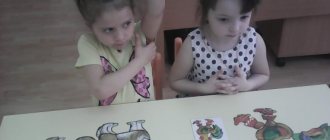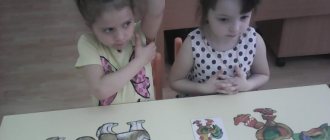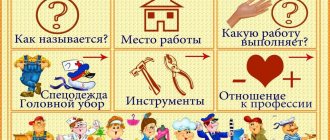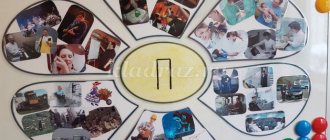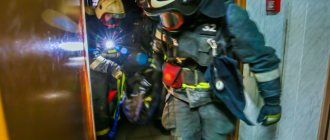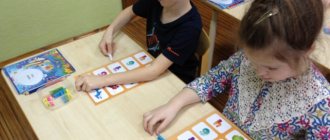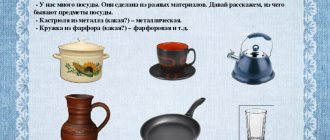How to work with the material?
Our selection of cards is designed to develop children's speech and thinking, familiarize them with the world around them and form initial ideas about professions.
The manual can be used for classes with children from two and a half years old, but it can and should be taught at both 4 and 5 years old. It’s just that activities with a child at different ages are structured differently. So, for a child of two and a half years old it is enough if he knows the name of the profession and can name most of the objects shown in the picture. We already expect from a three-year-old child that he not only knows the names of objects of labor, but can also tell in what profession these objects are used. At 4 years old, a child understands the purpose of most tools and can talk about what a person does in a particular profession.
You can download free pictures of various professions for children. They are suitable for thematic classes, both at home and in early development clubs, in junior schools.
Your child will get to know such professions as: secretary, carpenter, cook, reporter, tour guide, policeman, director, welder, courier, nun, psychic, inspector, dentist, pharmacist, drummer, driver, artist, stylist, district police officer, waiter, nurse, flight attendant, bellhop, pilot, architect, nanny, doctor, singer, guide, cashier, musician, ceramic artist, fireman, hairdresser, photographer, salesman, engineer, veterinarian, teacher, accountant, builder.
How you can study professions with your child.
1) To begin, offer your child a completed playing field, study all the pictures with him and tell him about each profession and what professional tools are needed for.
2) Then you can offer the child empty playing fields and cards for them, and fill them out together.
3) In the future, the child himself will be able to play this game like lotto: choose cards from a box or bag and place them on the playing fields.
You can study professions using these educational materials with one child or in a group of children. In addition, you can also print part 1 of the “Learning Professions” materials on our website. Then you will have 8 playing fields and 64 cards.
All educational materials on our website, for classes with children at home, in kindergarten or in primary school, are adapted for A4 paper format. You can download them for free and print them out.
Download link at the end of the article.
Educational game for children “Learning professions” part 2, profession of auto mechanic
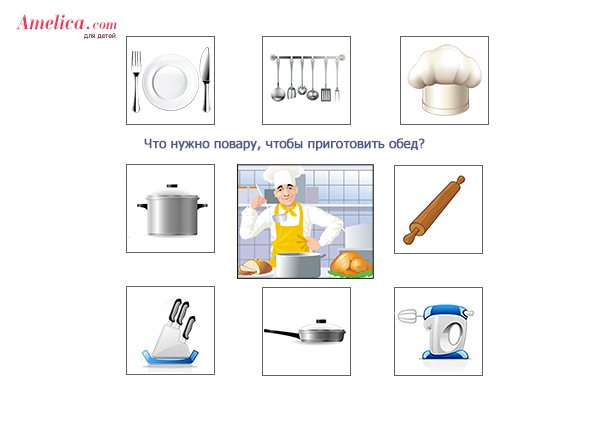
Educational game for children “Learning professions” part 2, profession chef
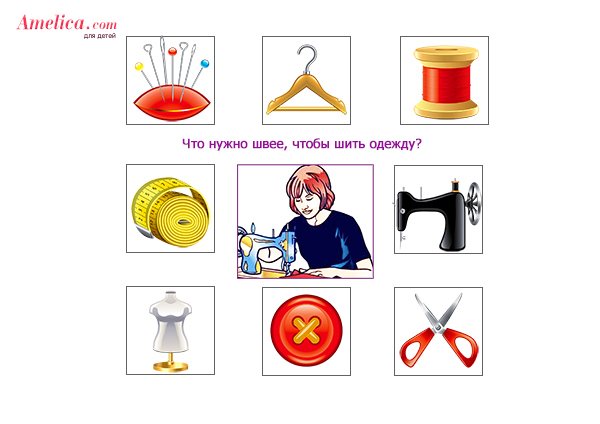
Educational game for children “Learning professions” part 2, profession seamstress
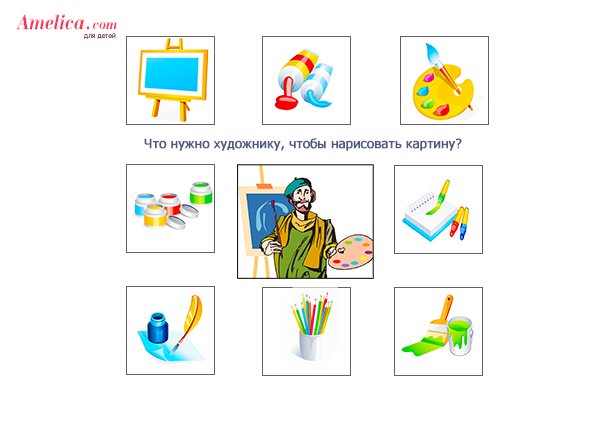
Educational game for children “Learning professions” part 2, profession artist
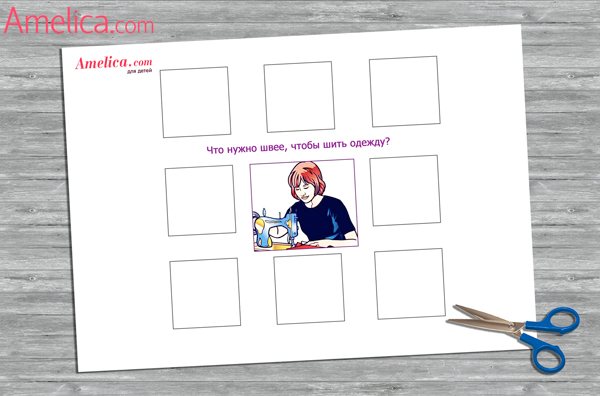
Educational game for children “Learning professions” part 2, playing field - seamstress profession
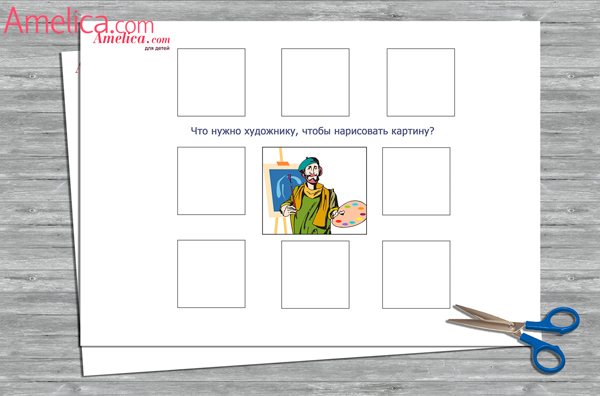
Educational game for children “Learning professions” part 2, playing field - profession artist
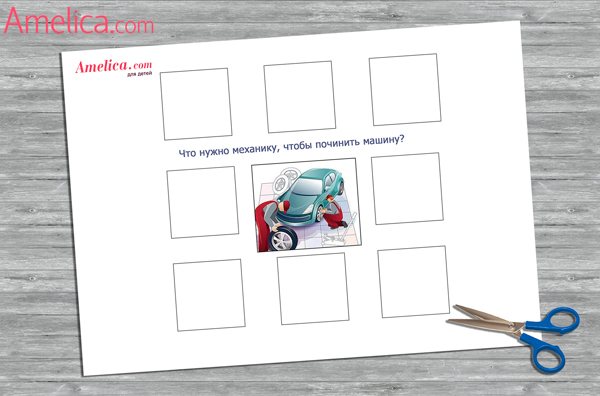
Educational game for children “Learning professions” part 2, playing field - profession auto mechanic
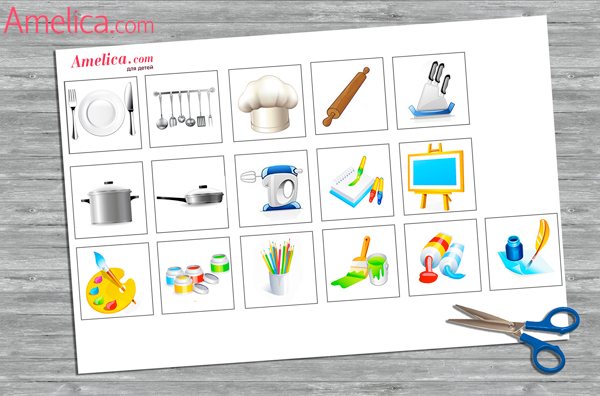
Educational game for children “Learning professions” part 2, cards with professional tools
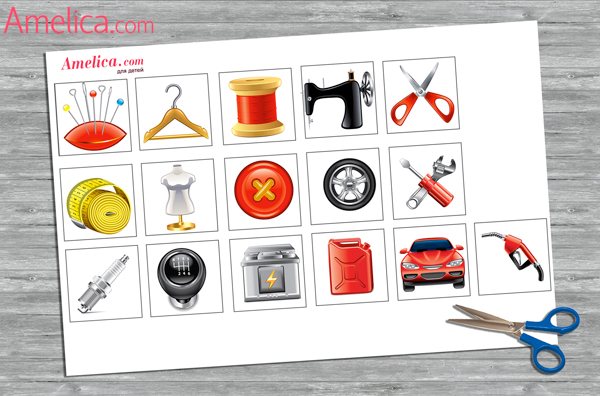
Educational game for children “Learning professions” part 2, cards with professional tools
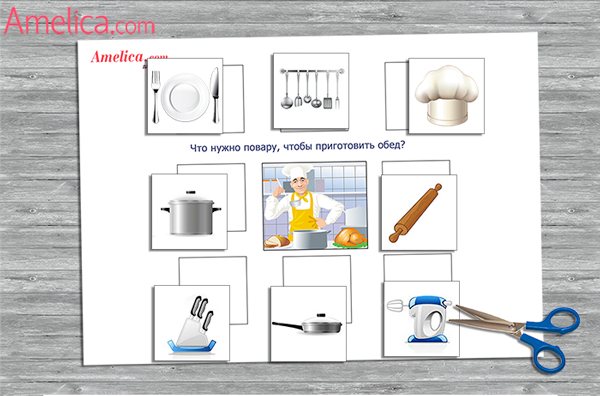
Educational game - lotto for children “Learning professions (professions pictures)”

Educational game - lotto for children “Learning professions (professions pictures)”
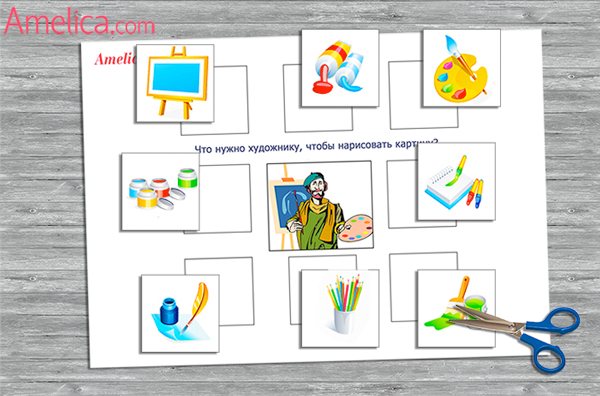
Educational game - lotto for children “Learning professions (professions pictures)”
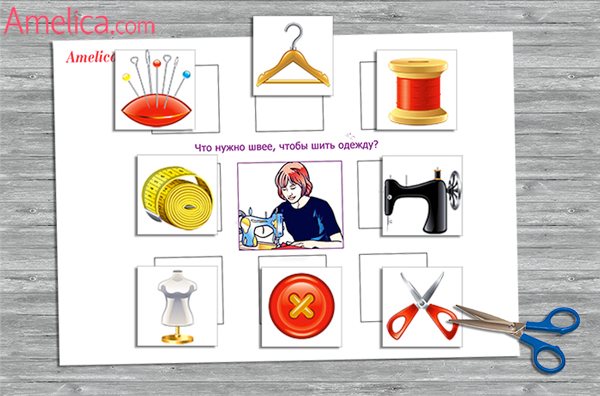
Educational game - lotto for children “Learning professions (professions pictures)”
What's the best way to tell it?
- For example, let's talk about the profession of a doctor. A doctor is a very necessary profession. The doctor is dressed in a white coat and has a special cap on his head. This is a doctor's form. The doctor treats children and adults from diseases. The doctor works in the hospital. For his work, he needs special tools, such as a phonendoscope, syringe, thermometer, etc. The profession of a doctor is needed in order to protect and treat people from various diseases. With the help of these profession cards in pictures, your child will expand his horizons, learn a lot of new things, develop speech, especially important for 3 years old, and memory. You can download professions in pictures here completely free of charge - click on the image below to download for free:
- A seller, for example, sells goods in a store. This profession requires communication skills and accuracy. The seller must also be able to count well, and the child’s attention should be focused on this.
- An engineer is a complex technical profession that requires good knowledge of mathematics and technology. An engineer can find use in a factory when creating new technical developments.
- A driver is needed everywhere. This is not just a person who drives a taxi. Drivers are required at enterprises, at construction sites, for intercity cargo transportation, etc. This profession requires endurance, attention and, of course, the ability to drive a car.
- A veterinarian treats animals. He must have a medical education. And, of course, the veterinarian must love our little brothers.
- The cook loves to cook, but he does it according to culinary standards and requirements. A cook is needed not only in canteens or restaurants, but also in organizations, schools, and kindergartens.
- The builder participates in the construction of houses. This profession requires physical strength. Construction is a very necessary profession.
- The hairdresser does our hair. A hairdresser must have dexterous hands and a subtle artistic taste.
- An accountant calculates costs and profits at enterprises, firms, and organizations. An accountant must have an economic education and have mathematical abilities.
- A teacher is a rather difficult profession. It is necessary not only to be able to present the material in an interesting way, but also to organize the children’s work. The teacher must have moral restraint and tact, and know his subject well.
Didactic games on the topic “Professions” 3-4 years
Didactic games
Didactic board game on the topic : “ Professions ”
.
for children 4-7 years old
Goal: expand children's understanding of various professions , their names and types of activities. Introduce tools and instruments needed by people of these professions and relate them. Foster respect for the work of adults.
Progress of the game: Participants are asked to take turns naming the professions that they already know and the tools that people in these professions , then try to correlate the actions of people with their profession , forming corresponding verbs from nouns (educator - educates, builder - builds, etc.)
.
The teacher draws the children's attention to the fact that unusual chests have appeared in the group, people of different professions , but they are empty, all the tools are mixed up, and people cannot work. Give the children a chest each. Then the adult invites one participant at a time to his table (everyone can sit at a round table)
. He takes the card and says what is shown on it. The rest of the children must name someone, this item is needed for work, and put it in the chest. If the children find it difficult to answer, explain what it is like with children, remember where they saw such an employee.
Let's show the doll how a hairdresser works
Goals:
· Clarify knowledge about the work of a hairdresser;
· Continue to formulate the idea of the need to maintain a clean body and a neat appearance.
Equipment:
2 dolls, attributes for playing hairdresser.
Contents of the game.
The teacher brings a large doll, which says that it came from another kindergarten, where the children do not know how to play hairdresser. The teacher asks to help the doll, tell and show how to play this game.
The teacher clarifies with the children what items are needed, how to prepare the place for the game, and offers to explain and show the actions of the hairdresser. The scope of actions depends on the children’s corresponding ideas.
Let's make beautiful hairstyles for the dolls
Goals:
· Strengthen the skills of caring for hair, etc.), asks to put them in order, to do their hair. She clarifies what items are needed for this, draws attention to the fact that the dolls’ hair is of different lengths, so their hairstyles should be different. The teacher suggests remembering what hairstyles can be made from long and short hair and shows some techniques; children continue to work with hair;
· Specify the names of the items required for this;
· Form the concept of “neat appearance.”
Equipment:
dolls with hair of different lengths, hair care items.
Contents of the exercise.
The teacher draws the children's attention to the unkempt appearance of the dolls (they are without socks and shoes, their hair is not neat)
«Determine the profession by subject
».
Goal: To consolidate an understanding of the purpose and functions of objects of labor, the ability to group them by method of use.
Procedure: Children take turns taking out objects from the bag (ladle, cotton wool, coins, comb, paint, threads, syringe, etc., which are necessary for one or another professional activity. Task: for the object, name the profession in which it is used.
"We're going to work"
Target:
teach children to navigate the space of the room, find their place in accordance with visual landmarks - pictures depicting professional symbols. Develop attention and memory during this game.
Game actions:
moving around the room (depicting a car ride) and finding a chair or place with the corresponding professional symbols (picture).
Game equipment:
“rudders” (circles with people of different professions drawn in the middle) are laid out on the teacher’s table; there are chairs in different places in the room, with pictures depicting tools on them.
Progress of the game:
the teacher invites the children to his table, everyone can choose a profession, take the steering wheel and go to work, to do this you need to carefully look at the chairs and choose a picture with a tool suitable for this job. The game is played several times, the teacher rearranges the pictures on the chairs, and the children must find their place again. Then the children change rudders (professions), and the game is repeated
“What does Masha want to do?”
Target:
clarify children’s ideas about certain work activities; about materials, tools and equipment needed for work.
Progress of the game: in
The teacher addresses the children on behalf of Masha (doll):
- Masha asks me for a basin, a bucket of water and soap.
Submits the objects she calls to the doll.
- What do you think she will do? (Wash.) That's right. And now Masha asks to give her a saucepan, milk, sugar, salt and millet. What is Masha going to do? (The doll wants to cook porridge.) What is the name of the porridge? (Millet.)
Other work activities that require appropriate items can be considered in a playful form. The kids are shown these items (an iron and a stack of doll's laundry - for ironing; a bucket and a watering can - for watering the beds, etc.).
When playing this game with older children, the teacher uses pictures depicting objects corresponding to a particular type of labor, or simply lists these objects (without showing illustrations), asking the children to guess more complex labor processes. For example: scissors, colored paper, glue, ruler, pencil - gluing books, repairing boxes, paraphernalia.
The game can be complicated: one child draws objects on the board, and the rest of the children guess the type of work, or all children simultaneously draw on paper, and then show the drawings to each other and guess.
«Guess what I'm doing?
Target
: expand children’s understanding of labor activities; develop attention.
Progress of the game:
The teacher and children join hands and stand in a circle. A child comes to the center of the circle. Everyone goes in a circle and says:
We don’t know what you’re doing,
Let's take a look and guess.
The child imitates labor actions not only with movements, but also (if possible) with sounds. For example, he cleans the floor with a vacuum cleaner, hammers a nail, saws, drives a car, does laundry, carries a bucket of water, wipes a mirror, chops wood, grates, turns something in a meat grinder, etc.
Children guess the actions.
“What do they do with this object?”
Target:
teach children to select words indicating the action performed by the object and who uses this object.
For example:
With a brush - (what are they doing?) - Drawing, (who?) - Artists, children.
With scissors - (what are they doing?) - Cutting, (who?) - Cutters, hairdressers.
With a needle - (what do they do?) - Sew, (who?) - Seamstresses, embroiderers.
With a shovel - (what are they doing?) - Digging, (who?) - Gardeners.
With a pen - (what do they do?) - Write, (who?) - Teachers, writers, accountants.
With an ax - (what are they doing?) - Chopping (who?) - Carpenters, foresters.
With a thermometer - (what are they doing?) - They measure the temperature, (who?) - Doctors, weather forecasters.
With a ruler - (what are they doing?) - Measuring, (who?) - Engineers, designers, schoolchildren.
With a broom - (what are they doing?) - Sweeping, (who?) - Janitors, etc.
“For a person in what profession is this necessary?”
Target:
expand children’s understanding of the items necessary for a person in a certain profession.
Progress of the game:
Scales, counter, goods, cash register... - to the seller.
Broom, shovel, hose, sand, crowbar, snow blower... - to the janitor.
Washing machine, bath, soap, iron... - to the laundress.
Comb, scissors, hair dryer, shampoo, hairspray, hair clipper... - to the hairdresser, etc.
"Guess the profession"
Target:
expand children’s understanding of the profession; find out what profession we are talking about.
Progress of the game:
This person is the owner of a wonderful palace of books. She is sincerely glad to see everyone who comes to visit her. And most importantly, guests will never leave her empty-handed. She gives them interesting books to take home. After reading, they can be exchanged for others. She will always help young and adult readers find the right book. (Librarian).
When you are hungry and come to the group for lunch, it already smells delicious. Who did this hard? Who prepared this tasty and aromatic dish? This is her favorite pastime, she does it with great love, that’s why everyone likes the food so much. For what a person does with pleasure and love brings joy not only to herself, but also to everyone else. Who is this? (Cook).
And this man greets his patient with a smile, quickly drives away unbearable pain, and cures all kinds of diseases. Once in his childhood, this man came to the aid of sick animals and loved ones, because he loved them very much and tried to reject the pain. And then I realized that I couldn’t live without it, so I studied for a long time and became (a Doctor).
When you come to kindergarten, everything around you is clean, comfortable, and fresh air. Not a speck of dust anywhere. The floor has been washed, the glass on the windows is so transparent that it is almost invisible. This person loves cleanliness very much and does his job with pleasure. She has great talent for this. Whose hands is this work? (Cleaners, assistant teacher).
Tell children about professions
All professions are important, all professions are needed
An original didactic game to reinforce ideas about adult professions among preschoolers aged 5-7 years
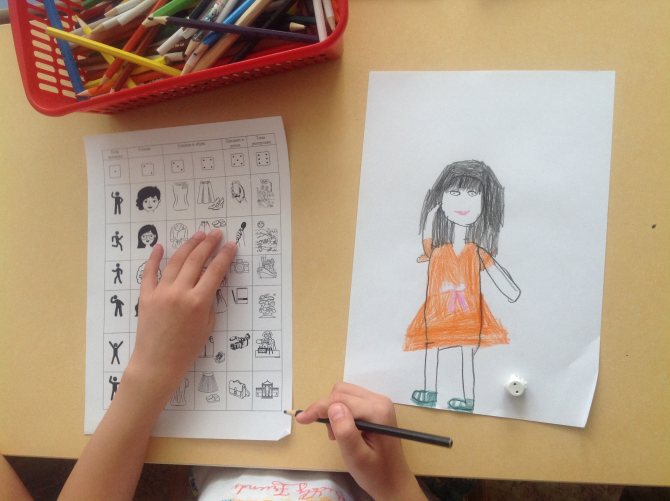
We would like to present to our readers the game “Choose a Profession,” which we developed to develop in older preschoolers an emotionally positive attitude towards work and interest in the professions of adults. The dual nature of the didactic game - educational orientation and game form helps to support a child's dream and connect the desire for it with the desire to work.
We noticed that preschoolers showed interest in the game task “Make an identikit.” When performing it, based on the number of dots that fell on the dice, the children selected the corresponding details of appearance in the tables, redrew them and made up an image of the person. Thus, preschoolers got different images of characters: funny and funny, sad and cheerful.
The children’s desire to sketch different versions of the identikit led us to think about the reason why such an activity is attractive to them. Preschoolers love to draw, they are interested in the process of drawing itself, but there are not many educational games with drawing. The task is unusual because there is intrigue in it: you will never guess what will happen in the end. There is no competition when compiling and drawing an identikit; everyone who plays is a winner. Children get involved in the game with excitement; drawing captivates them and arouses great interest. Preschoolers are especially pleased and surprised by the new image that results from the game. They look at the drawings with interest, discuss them with their peers, and are happy to show their work to their parents. We decided to use a playful technique that was attractive to children, which they learned to confidently use when drawing up an identikit, when introducing preschoolers to the world of professions. This is how our group created the didactic game “Choose a Profession,” which helps children learn about modern professions of adults and professions of the future. This game has a series of options: “I will become a doctor”, “I will become a stylist”, “I will become an engineer” and others. Each version of the game not only helps children get acquainted with the world of professions, but also develops attention, vocabulary, the ability to construct sentences, and gives each player the opportunity to show their creative abilities. The rules provide for the players to alternately participate in determining the details of the image of a person in the chosen profession and sequentially complete the drawing, therefore the game “Choose a Profession” helps to develop voluntary behavior and teamwork skills in preschoolers. Let’s explore it using the example of the game version “I’ll become a journalist.”
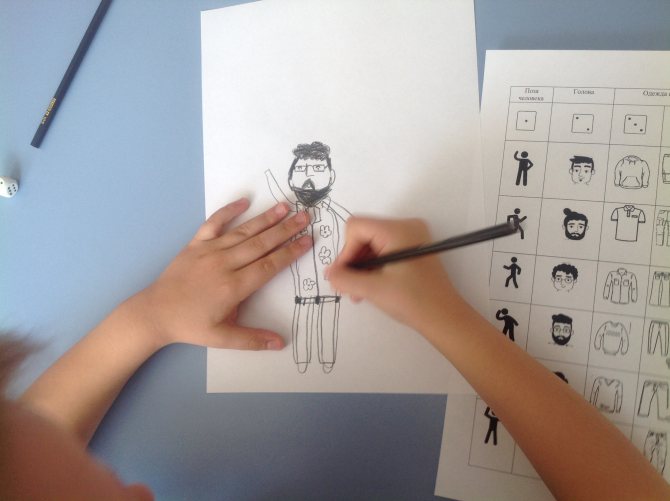
Material
: dice; tables with elements of human images, sets of felt-tip pens and colored pencils, sheets of A4 paper according to the number of participants in the game.
Option 1
. Up to six older preschoolers can take part in the game.
Rules of the game
. We invite children to imagine that they have become adults and chosen the profession of a journalist. Then we invite you to draw yourself in the image of your chosen profession, using the table for step-by-step drawing. To maintain the interest of preschoolers in the game and generalize knowledge about the professions of adults, gender differences are provided in the appearance of the characters. They are expressed in hairstyle and clothing, so there are two versions of tables: for drawing a man - a journalist, and for drawing a woman - a journalist. Each child chooses a table of their own choosing, with boys more often choosing a table with details of male affiliation, and girls more often choosing female ones. After the tables have been selected, the children take turns throwing the dice and, each time, based on the number of dots that appear on it, they choose the option to depict the journalist’s body parts, his clothes and the equipment necessary for work. The dice is rolled 6 times and the following is determined: 1 - the person’s posture; 2 - image of his head; 3 and 4 - images of clothes and shoes; 5 – equipment necessary for work - notepad and pen, microphone, telephone, camera or other; 6 - the topic of the report that the journalist is preparing. Children independently choose the color of the journalist’s hair, clothes and shoes, and color the elements of the picture. When the drawing is finished, we invite preschoolers to describe the appearance of each journalist and come up with a short story about the preparation of the report.
Option 2
. Any number of participants can play. If there are many people who want to take part in the game, then we invite children to play in subgroups of 3-5 people, taking into account their choice. The above rules apply in each subgroup.
Option 3
. Each participant in the game has his own cube. In this case, all players throw the dice simultaneously before each stage of drawing in a limited space in front of them. The drawing sequence is the same as in option 1. Discussion of the resulting drawings - one by one.
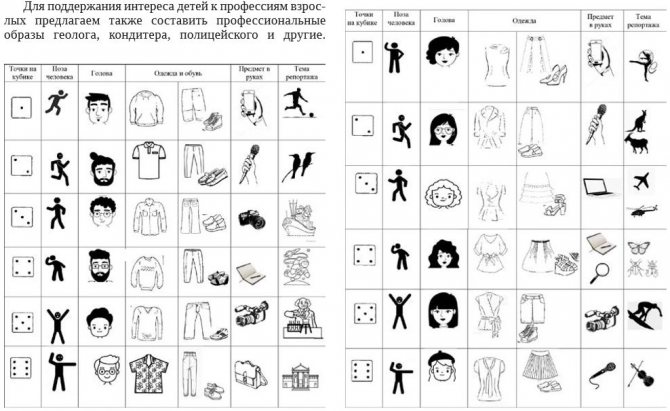
To maintain children's interest in the professions of adults, we also suggest creating professional images of a geologist, pastry chef, policeman, and others. The drawings always turn out different, they cannot be predicted, so preschoolers create unique pictures with pleasure and interest. Any version of the game has a projective orientation, helps the child, while drawing, to immerse himself in the profession and, as it were, “try it on” for himself. Older children tend to want to complete their drawing with imagination. They become interested in the details of the image of an adult and the various ways in which he performs real work activities. It is very important that this game enriches preschoolers’ understanding of the professional actions of adults and contributes to the development of story-based role-playing games. Teachers can use the game “Choose a Profession” to fill out a lapbook on the topic “Professions” or as an independent game. Experience has shown that parents are happy to use it when spending family leisure time with their children. The game material takes up little space, so you can take the game on the road for a fun and interesting pastime.
Yulia Yakubovich, teacher
Irina Barinova, educational psychologist, School No. 1357, Moscow
Abstract of the GCD for children of middle preschool age “Who is a mechanic?” (professions)
Olga Podgornykh
Abstract of the GCD for children of middle preschool age “Who is a mechanic?” (professions)
Summary of direct educational activities on the formation of a holistic picture of the world for children of middle preschool age
Topic: What is a locksmith?
Software tasks:
• To consolidate and generalize children’s ideas about the work of a mechanic
• Show the importance of this profession
• Form ideas about the safe work of a mechanic, about the tools that help him in his work
• Develop cognitive interest, curiosity
• Foster a respectful attitude towards work, the basics of safe handling of tools.
Material: illustrations of a mechanic, pictures of tools, hammer, file, screwdriver, hacksaw.
Preliminary work: reading the story by T. A. Shorygina “Danilka and the File”
Progress:
- Guys, let's imagine that our faucet is leaking... What are we going to do? (Children's answers.)
- That's right, we need to call a locksmith.
- And if the lock is broken, who can help? Again - a locksmith!
— What if the bike breaks down and dad can’t fix it himself?
— Is the key broken? Again, locksmith!
It turns out that the profession of a locksmith is so important and necessary. What kind of jack of all trades is this?
A locksmith is a very old profession; he works with metal and is well versed in products made from it. To deal with metal, a mechanic has special tools. Who knows which ones? (Children's answers.)
— A hammer and a chisel help the mechanic: he placed the chisel at a sharp angle to the metal, hit the other end with a hammer, and cut off a piece of metal (I show the illustration). You can also cut off the required piece of metal using a hacksaw saw (I show a hacksaw).
It has very sharp teeth and it itself is made of, look what? That's right, made of very durable metal. Why does a mechanic need a screwdriver? (Children's answers.)
The mechanic uses a screwdriver to screw in the screws, but for the bolts and nuts the mechanic has a special wrench (I’m showing you). The file helps him make the surface of the metal completely smooth. To ensure that all parts are made accurately and to size, the mechanic has many measuring instruments and tools. A locksmith can not only repair old items, but also make new ones.
So it turns out that a lot of tools help a mechanic in his work - sharp and dangerous, but very necessary.
How should he treat his assistants (Children's answers.)
- Right. When using any tool, certain safety rules must be followed. Each tool has its own rules. I will now introduce some of them. Let's start with the hammer. Who knows how to work with him? (Children's answers.)
- So, when working with a hammer, attention is required, the hand should not be at the very head of the hammer (I’m showing, but not at the very edge of the handle. Keep your fingers away from the nail head. If the nail is bent, then you cannot continue hitting it!
Never stand next to a person using a hammer! Why? (Children's answers.)
- Well done, he may accidentally hit you or the nail may bounce off.
Another very dangerous, but necessary tool is a hacksaw, which also requires increased attention when working.
You only need to hold the saw by the handle (I’m showing you, you can’t put your fingers under the teeth!
There are still a lot of tools that help a locksmith, let's remember what else helps him in his work? Children's answers. Well done, you named a lot of tools that he needs. But they can be not only useful, but also very dangerous - after all, most of them are sharp, piercing, cutting. You can easily get hurt by them if you don’t follow what? That's right, safety rules. Remind me what is required first of all when working with any tools? (Children's answers.)
- Well done, attention and caution. Do you think children can use them? (Children's answers.)
- Remember - you should not take a tool and work without the permission of an adult and without his presence. You can’t play with them, you need to handle them with care and precision, don’t leave them anywhere, try not to let moisture get on them, why? They may rust and become less efficient or completely deteriorate. Well, after work, all tools must be put away in a specially designated place. Now, let's remember everything we learned about such an important profession.
Questions for children:
• What is a locksmith? Why is his work important?
• What tools help him in his work?
• Tell us what rules must be followed when working with a hammer or a hacksaw?
• Why can't you play with instruments?
• Where and why should tools be stored?
Well done, guys, you told everything correctly, and now let's help the mechanic - you need to paint only those tools that he needs in his work.
